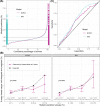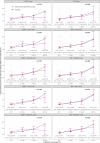Validation of breast cancer risk assessment tools on a French-Canadian population-based cohort
- PMID: 33846154
- PMCID: PMC8047995
- DOI: 10.1136/bmjopen-2020-045078
Validation of breast cancer risk assessment tools on a French-Canadian population-based cohort
Abstract
Objectives: Evaluate the accuracy of the Breast Cancer Risk Assessment Tool (BCRAT), International Breast Cancer Intervention Study risk evaluation tool (IBIS), Polygenic Risk Scores (PRS) and combined scores (BCRAT+PRS and IBIS +PRS) to predict the occurrence of invasive breast cancers at 5 years in a French-Canadian population.
Design: Population-based cohort study.
Setting: We used the population-based cohort CARTaGENE, composed of 43 037 Quebec residents aged between 40 and 69 years and broadly representative of the population recorded on the Quebec administrative health insurance registries.
Participants: 10 200 women recruited in 2009-2010 were included for validating BCRAT and IBIS and 4555 with genetic information for validating the PRS and combined scores.
Outcome measures: We computed the absolute risks of breast cancer at 5 years using BCRAT, IBIS, four published PRS and combined models. We reported the overall calibration performance, goodness-of-fit test and discriminatory accuracy.
Results: 131 (1.28%) women developed a breast cancer at 5 years for validating BCRAT and IBIS and 58 (1.27%) for validating PRS and combined scores. Median follow-up was 5 years. BCRAT and IBIS had an overall expected-to-observed ratio of 1.01 (0.85-1.19) and 1.02 (0.86-1.21) but with significant differences when partitioning by risk groups (p<0.05). IBIS' c-index was significantly higher than BCRAT (63.42 (59.35-67.49) vs 58.63 (54.05-63.21), p=0.013). PRS scores had a global calibration around 0.82, with a CI including one, and non-significant goodness-of-fit tests. PRS' c-indexes were non-significantly higher than BCRAT and IBIS, the highest being 64.43 (58.23-70.63). Combined models did not improve the results.
Conclusions: In this French-Canadian population-based cohort, BCRAT and IBIS have good mean calibration that could be improved for risk subgroups, and modest discriminatory accuracy. Despite this modest discriminatory power, these tools can be of interest for primary care physicians for delivering a personalised message to their high-risk patients, regarding screening and lifestyle counselling.
Keywords: breast tumours; epidemiology; genetics; preventive medicine; public health.
© Author(s) (or their employer(s)) 2021. Re-use permitted under CC BY-NC. No commercial re-use. See rights and permissions. Published by BMJ.
Conflict of interest statement
Competing interests: None declared.
Figures




References
-
- Canadian Cancer Statistics Advisory Committee . Canadian cancer statistics 2019. Toronto, ON: Canadian Cancer Society, 2019. cancer.ca/Canadian-Cancer-Statistics-2019-EN
MeSH terms
LinkOut - more resources
Full Text Sources
Other Literature Sources
Medical
